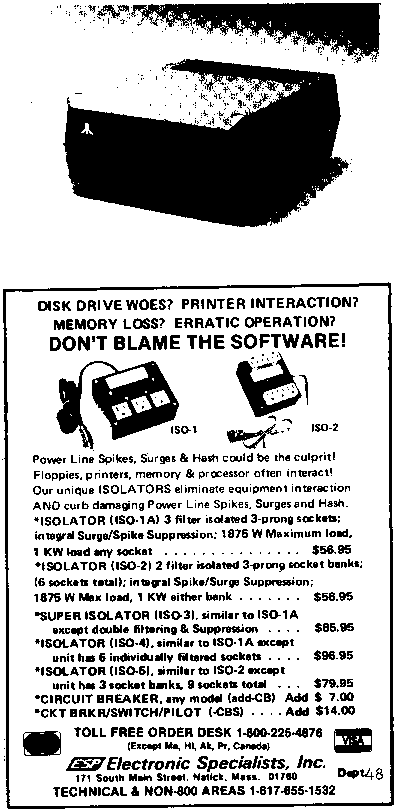|
|
STAR TREK 3.5 | 3-D STAR TREK | ||
| Dynacomp, Inc. | Adventure International | Color Software | ||
| 6 Rippingale Rd. | Box 3435 | 5410 W. 20th St. | ||
| Pittsford, NY 14534 | Longwood, FL 32750 | Indianapolis, IN 46224 | ||
| Cassette $9.95 24K - Disk 113.95 32K | Cassette $14.95 | Cassette $15.00 24K | ||
| *CREATIVE COMPUTING STAR TREK | TARI TREK |  |
||
| From: Basic Computer Games (No. 6C) | Quality Software | |||
| Creative Computing 6660 | Reseda Blvd., Suite 105 | |||
| P.O. Box 789-M | Reseda, CA 91335 | |||
| Morristown, NJ 07960 | Cassette $11.95 24K - Disk $14.95 32K | |||
| *(must be converted for Atari) - $7.50 Book |
The ATARI 8 10 Disk Drive is now supported by
the release of the Disk Operating System Reference
Manual made available last fall. New drives should
be coming through with this manual. A new version
of DOS; DOS II, Version 2S, will be available soon
for the 810. This new version has a number of
differences over the original DOS. DOS II takes up
less memory, as it doesn't reside in RAM along side
your BASIC or ASSEMBLY language program.
When you type in the DOS command, your
program in RAM is swapped to a file on diskette -
the "MEM.SAV" file. Then DOS is put in RAM for
your use. Type "B" and DOS is erased from RAM,
and your program is put back in RAM. This allows
you to use more RAM for programming rather than
have DOS use up 9 or 10 K.
DOS 11 does away with the 'N. DEFINE DEVICE'
function. 'N' will now create a new "MEM.SAV"
file on diskette. You also won't have to return to the
MENU on DOS after you execute a command, you
can just type in a new command, or hit 'RETURN'
for the MENU listing. The four files comprising
DOS 11 are: DOS.SYS, DUP.SYS, MEM.SAV, &
AUTORUN.SYS. Also, some formatting on DOS 11
is not interchangable with DOS 1. You can run into
difficulty renaming a DOS I formatted diskette on
DOS 11 (the file name storage differs slightly). DOS
11 supports the point/random access functions on
disk now.
You may notice how reliable your disk drive is in
the way it never loses data transferring from diskette
to RAM or visa versa. When data is taken to or from
diskette, a 'counter' checks to see that the number of
bits transferred matches what was originally in the
file or program.
*Note that when the final version of DOS 11 is
released, some of what has been described may
change.
